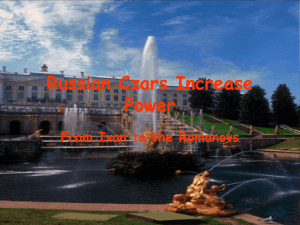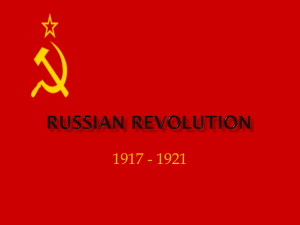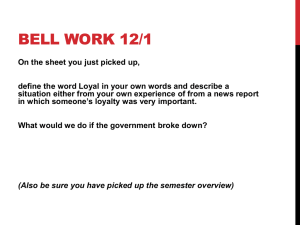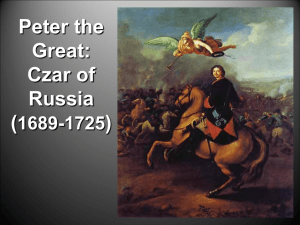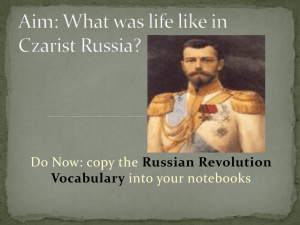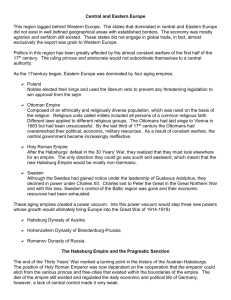Russian Empire 1450-1750 Study Guide
advertisement
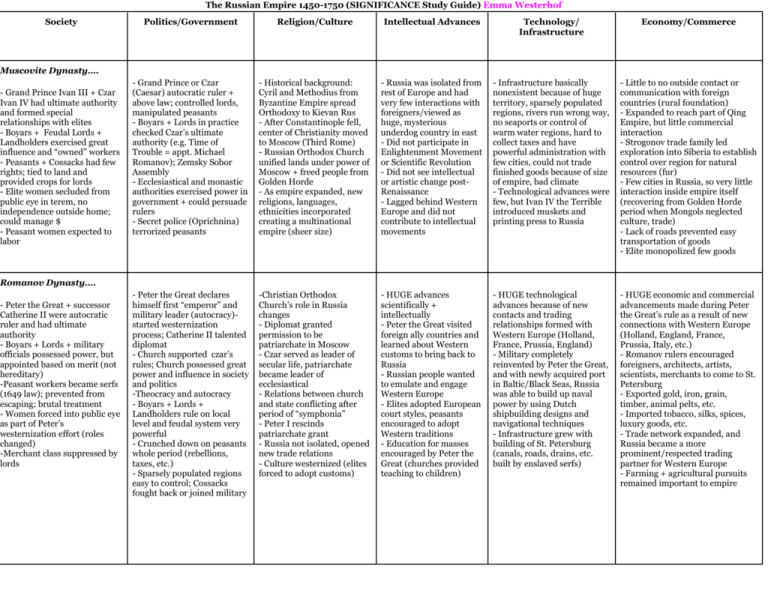
The Russian Empire 1450-1750 (SIGNIFICANCE Study Guide) Emma Westerhof Society Politics/Government Religion/Culture Intellectual Advances Technology/ Infrastructure Economy/Commerce - Grand Prince or Czar (Caesar) autocratic ruler + above law; controlled lords, manipulated peasants - Boyars + Lords in practice checked Czar’s ultimate authority (e.g. Time of Trouble = appt. Michael Romanov); Zemsky Sobor Assembly - Ecclesiastical and monastic authorities exercised power in government + could persuade rulers - Secret police (Oprichnina) terrorized peasants - Historical background: Cyril and Methodius from Byzantine Empire spread Orthodoxy to Kievan Rus - After Constantinople fell, center of Christianity moved to Moscow (Third Rome) - Russian Orthodox Church unified lands under power of Moscow + freed people from Golden Horde - As empire expanded, new religions, languages, ethnicities incorporated creating a multinational empire (sheer size) - Russia was isolated from rest of Europe and had very few interactions with foreigners/viewed as huge, mysterious underdog country in east - Did not participate in Enlightenment Movement or Scientific Revolution - Did not see intellectual or artistic change postRenaissance - Lagged behind Western Europe and did not contribute to intellectual movements - Infrastructure basically nonexistent because of huge territory, sparsely populated regions, rivers run wrong way, no seaports or control of warm water regions, hard to collect taxes and have powerful administration with few cities, could not trade finished goods because of size of empire, bad climate - Technological advances were few, but Ivan IV the Terrible introduced muskets and printing press to Russia - Little to no outside contact or communication with foreign countries (rural foundation) - Expanded to reach part of Qing Empire, but little commercial interaction - Strogonov trade family led exploration into Siberia to establish control over region for natural resources (fur) - Few cities in Russia, so very little interaction inside empire itself (recovering from Golden Horde period when Mongols neglected culture, trade) - Lack of roads prevented easy transportation of goods - Elite monopolized few goods - Peter the Great declares himself first “emperor” and military leader (autocracy)started westernization process; Catherine II talented diplomat - Church supported czar’s rules; Church possessed great power and influence in society and politics -Theocracy and autocracy - Boyars + Lords + Landholders rule on local level and feudal system very powerful - Crunched down on peasants whole period (rebellions, taxes, etc.) - Sparsely populated regions easy to control; Cossacks fought back or joined military -Christian Orthodox Church’s role in Russia changes - Diplomat granted permission to be patriarchate in Moscow - Czar served as leader of secular life, patriarchate became leader of ecclesiastical - Relations between church and state conflicting after period of “symphonia” - Peter I rescinds patriarchate grant - Russia not isolated, opened new trade relations - Culture westernized (elites forced to adopt customs) - HUGE advances scientifically + intellectually - Peter the Great visited foreign ally countries and learned about Western customs to bring back to Russia - Russian people wanted to emulate and engage Western Europe - Elites adopted European court styles, peasants encouraged to adopt Western traditions - Education for masses encouraged by Peter the Great (churches provided teaching to children) - HUGE technological advances because of new contacts and trading relationships formed with Western Europe (Holland, France, Prussia, England) - Military completely reinvented by Peter the Great, and with newly acquired port in Baltic/Black Seas, Russia was able to build up naval power by using Dutch shipbuilding designs and navigational techniques - Infrastructure grew with building of St. Petersburg (canals, roads, drains, etc. built by enslaved serfs) - HUGE economic and commercial advancements made during Peter the Great’s rule as a result of new connections with Western Europe (Holland, England, France, Prussia, Italy, etc.) - Romanov rulers encouraged foreigners, architects, artists, scientists, merchants to come to St. Petersburg - Exported gold, iron, grain, timber, animal pelts, etc. - Imported tobacco, silks, spices, luxury goods, etc. - Trade network expanded, and Russia became a more prominent/respected trading partner for Western Europe - Farming + agricultural pursuits remained important to empire Muscovite Dynasty…. - Grand Prince Ivan III + Czar Ivan IV had ultimate authority and formed special relationships with elites - Boyars + Feudal Lords + Landholders exercised great influence and “owned” workers - Peasants + Cossacks had few rights; tied to land and provided crops for lords - Elite women secluded from public eye in terem, no independence outside home; could manage $ - Peasant women expected to labor Romanov Dynasty…. - Peter the Great + successor Catherine II were autocratic ruler and had ultimate authority - Boyars + Lords + military officials possessed power, but appointed based on merit (not hereditary) -Peasant workers became serfs (1649 law); prevented from escaping; brutal treatment - Women forced into public eye as part of Peter’s westernization effort (roles changed) -Merchant class suppressed by lords
